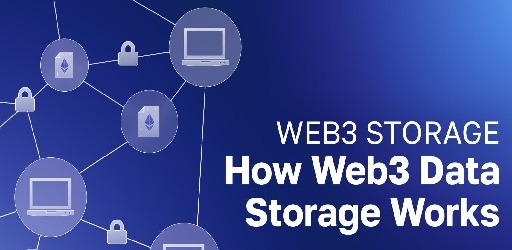Nowadays, secure storage of our files such as images, videos, and documents is crucial. While cloud storage and hardware devices are commonly used for data storage, a new method has emerged as a popular choice.
This new storage method is called Web3 storage. So, what exactly is Web3 storage, and how does it operate?

What is Web3?
Web3, also known as Web 3.0 or the decentralized web, refers to the next generation of the internet that is being built with decentralized technologies. This new version of the web aims to provide users with more control over their data, privacy, and security by reducing the reliance on centralized intermediaries and increasing the use of peer-to-peer networking.
Web3 technologies include blockchain, distributed ledger technology (DLT), decentralized file storage, and peer-to-peer networking protocols. These technologies enable the creation of decentralized applications (dApps) that can run on a decentralized network instead of relying on centralized servers.
Overall, the goal of Web3 is to create a more open, transparent, and user-centric internet that empowers individuals and communities to control their online identities, data, and digital assets.
What Is Web3 Storage?
Web3 Storage is a decentralized storage solution built on top of the InterPlanetary File System (IPFS) and the Filecoin network, both of which are Web3 technologies. It allows developers to store and retrieve data for their decentralized applications in a secure and reliable manner, without relying on centralized servers.
With Web3 Storage, developers can store any type of data, such as images, videos, and documents, and access it from anywhere in the world through a decentralized network of nodes. This ensures that the data is always available and cannot be tampered with or censored by any central authority.
In addition, Web3 Storage offers a simple and developer-friendly API that makes it easy to integrate with existing applications and workflows. It also provides tools and services to help developers manage their data, such as content addressing, versioning, and caching.
Web3 storage employs a decentralized approach to data storage, leveraging blockchain technology and a distributed model. In a Web3 storage network, user data is fragmented and distributed across multiple nodes, making it highly resistant to theft by malicious actors. Additionally, all fragments are encrypted and backed up with copies.
To retrieve files from Web3 storage platforms, users can request the file in the same way they would on a typical storage platform. However, instead of downloading the entire file from a single location, fragments are obtained from each node and then assembled to form the complete file.
In a decentralized storage network, no single device holds the complete file, making it virtually impossible for anyone to steal it.
Most decentralized storage platforms offer users their own private keys, which are necessary to access their data. Without the private key, the data cannot be accessed, giving users full ownership and control over their data. This aligns with the ownership principle of Web3, where individuals and communities have full control over their digital assets.
Overall, Web3 Storage is a key component of the Web3 ecosystem that enables developers to build decentralized applications with secure and reliable storage capabilities.
Are there issues with Current Cloud Storage?
The issue with the most widely used storage platforms is that they are centralized, which means that user data is stored in a single location. This centralization poses a significant problem as it creates a single point of failure.
A single point of failure is a vulnerability that can cause a network outage, leading to a system crash. However, in a decentralized storage network that relies on hundreds or even thousands of nodes, such outages, hacks, and other issues become much less likely to occur. The distributed nature of the network ensures that there is no central point of failure, making it more resilient and secure.
A centralized storage platform can be vulnerable to a distributed denial of service (DDoS) attack, which overwhelms the central server with traffic and causes it to crash. However, in a decentralized storage network, there is no central server to overwhelm, making a DDoS attack much more difficult (though not impossible).
Misusing stored data is also much more challenging in a decentralized structure. Centralized storage providers encrypt user data at rest, often with AES-256 encryption, which enhances security. However, these providers hold the decryption key to your data, not you. This requires you to trust the provider with your keys, which not everyone is comfortable with.
In contrast, on a Web3 storage platform, there is no central authority that holds your decryption keys. Your private encryption key, which is used to decrypt your files, is stored on your device and not accessible to anyone else.
Another interesting aspect of Web3 storage platforms is their use of cryptocurrencies.
The use of Cryptocurrencies in Web3 Storage
Web3 storage platforms use cryptocurrencies as a means of incentivizing participants to contribute their resources to the network. In a decentralized storage network, individuals or organizations can contribute their computing resources to store and distribute data, and in return, they receive compensation in the form of cryptocurrencies.
This compensation can be in the form of native tokens issued by the storage platform or other cryptocurrencies such as Bitcoin or Ethereum. By using cryptocurrencies, Web3 storage platforms create a decentralized and trustless economy where participants are incentivized to act in the best interests of the network.
In addition to incentivizing participants, cryptocurrencies also enable fast and secure transactions within the network. As transactions are recorded on a blockchain, they are immutable and tamper-proof, ensuring that all participants can trust the validity of the transactions.
Overall, the use of cryptocurrencies in Web3 storage helps to create a decentralized and incentivized network that enables secure and efficient data storage and distribution.
Is Web3 Storage a good idea?
Web3 storage is a highly secure method of data storage that utilizes blockchain technology and a distributed model, eliminating the need for a centralized entity to safeguard data.
If you are interested in decentralization and Web3 technology, Web3 storage is worth considering. It offers advanced security features such as encryption and data fragmentation, and its decentralized network provides a high level of protection against data breaches.
However, it is important to note that Web3 storage operates differently from centralized storage platforms, which may be challenging for some users. Before using a decentralized storage platform, it is essential to have a clear understanding of how your data will be processed and stored.
the future of Web3 Storage
As the need for virtual data storage continues to grow, the demand for secure storage solutions also increases. This is why Web3 storage platforms, with their high levels of security and stability, are becoming increasingly popular among users. It remains to be seen whether Web3 storage will eventually surpass traditional storage platforms, but its potential cannot be ignored.
Would you like to read more about Web3 Storage-related articles? If so, we invite you to take a look at our other tech topics before you leave!










